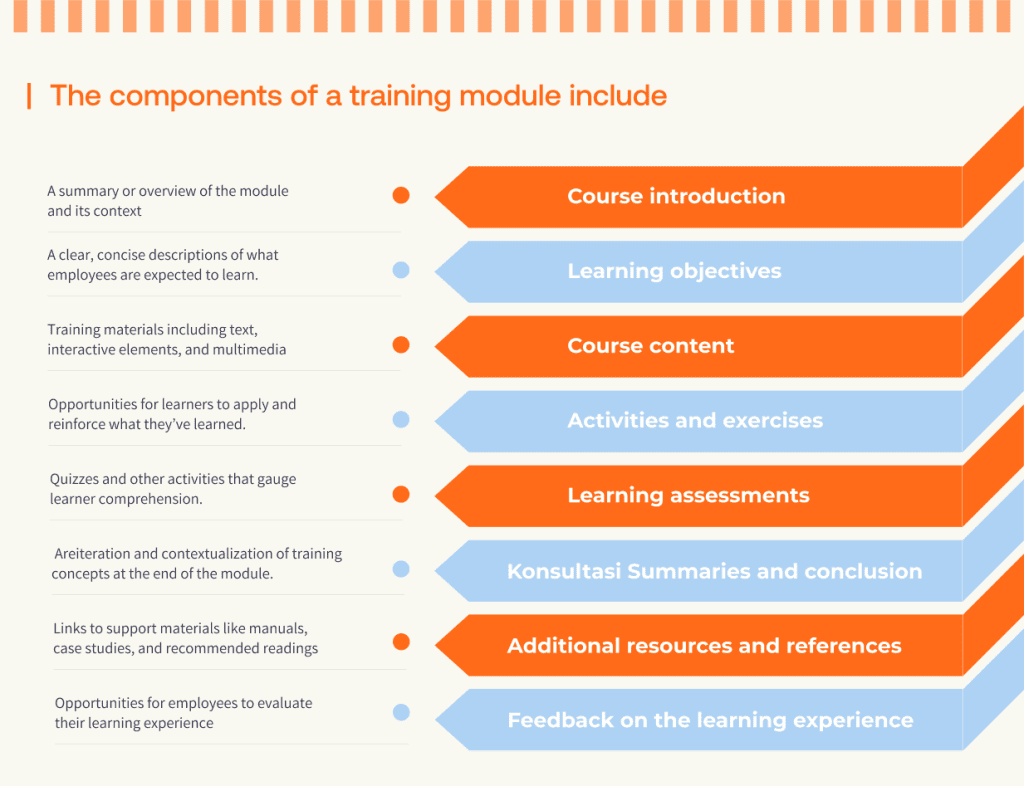How to Create Employee Training Modules
- Published:

As organizations strive to enhance team member skills and adapt to evolving industry standards, the importance of structured and engaging training content has never been more apparent. These training blueprints guide learners through complex concepts and practical skills while aligning individual growth with organizational goals.
This article explores the art of designing training material that captivates, educates, and empowers employees, setting the stage for continuous learning and success.
What Is a Training Module?
A training module is a component of a broader instructional program or course that focuses on a more specific topic. These modules can be completed in order, like steps that build on one another, or they can be accessed a la carte as needed. Once employees complete all the modules in a course, they will have mastered an important topic or skill.
With eLearning, especially, the modular nature of these lessons makes it possible to scale training and customize lessons as your organization and its workforce evolve.
The components of a training module include:
- Course introduction: a summary or overview of the module and its context within the larger training program.
- Learning objectives: clear, concise descriptions of what employees are expected to learn by the time they finish the module.
- Course content: training materials including text, interactive elements, and multimedia, that make up the body of the module.
- Activities and exercises: opportunities for learners to apply and reinforce what they’ve learned.
- Learning assessments: quizzes and other activities that gauge learner comprehension and retention of course content.
- Summaries and conclusion: a reiteration and contextualization of training concepts at the end of the module to reinforce learning and provide a recap of key concepts.
- Additional resources and references: links to support materials like manuals, case studies, and recommended readings to encourage further exploration into the topic.
- Feedback on the learning experience: opportunities for employees to evaluate their learning experience and provide feedback, often in the form of surveys.

Types of Training Module Formats
Provide employees with more engaging learning experiences by incorporating a variety of content in training modules. Here are some of the most effective and widely used training delivery methods for learning module formats
1. eLearning courses
An eLearning course is an online instructional course on a given topic. Rather than being led by an instructor, they are typically formatted as a series of slides containing text and other media such as photos or short videos. Each slide must have a clear message, and contain only as much information as a learner can easily focus on before moving forward.
This format is effective for a variety of training purposes, especially for standardized information, including security awareness and compliance training as well as onboarding.
2. Instructor-led modules
Instructor-led training often comes to mind when we imagine workplace learning. These modules are either delivered in-person or virtually, involving face-to-face instruction within a single physical space or synchronous virtual environment.
With instructor-led modules, employees learn from instructors and facilitators who are often subject matter experts and experienced lecturers who can answer employee questions and lead learners through interactive, collaborative activities.
Instructor-led training has proven to work well for a wide variety of important topics, including disseminating product and service knowledge, software and systems training, and compliance and safety regulations.
3. Webinars and video lectures
Video-based training formats such as webinars, screencasts, or instructional videos are commonly used in workplace training modules. This format is useful for capturing employee attention and keeping them engaged as they learn information and skills and other information that might come across as dry or confusing in other formats.
Video content is typically created by organizational leaders and subject matter experts, making their valuable insights and expertise accessible on demand. Video-based training works especially well for delivering complex tech and software tutorials as well as more traditional lectures being delivered by expert presenters.
4. Simulation-based modules
Simulation training allows learners to get hands-on experience performing complex tasks in low- and no-risk virtual environments. This type of module offers all the benefits of hands-on workplace training without requiring learners to physically come into a lab or workplace or use up valuable resources.
Simulation training experiences can benefit any organization but work especially well for career development in the areas of healthcare, aviation, education, and even business management, where hands-on training in real-life physical environments is unrealistic or cost-prohibitive.
5. Microlearning modules
Similar to the concept of training modules, microlearning is all about training employees on a given topic or task through short, digestible lessons. By zeroing in on a topic, microlearning lessons help employees brush up on product information or solve a problem in their moment of need. This type of module can stand on its own and does not necessarily need to be connected to a broader training course.
Microlearning modules work well for providing in-app or just-in-time training on process or policy updates or new products. They also serve as useful tools for practicing skills or reviewing knowledge, or as primers for more comprehensive training activities.
6. Role-play scenarios
Another common type of training module is a role-play scenario. These activities are commonly used in a variety of contexts, such as education or even therapy, but are also incredibly useful for workplace learning. In a role-playing activity, employees have the opportunity to rehearse interactions in a safe, risk-free setting.
These activities are especially effective for customer service training and sales training as well as for building communication skills more broadly.
7. Digital job aids and in-app guidance
Job aids are visually-based documents and instructions that employees can access as needed to help them complete daily job activities or resolve issues as they arise.
These aids come in a variety of formats like flowcharts, checklists, and step-by-step guides, process documentation that can be delivered via in-app guidance that walks employees through different tasks and processes. Training employees through digital job aids and in-app guidance can provide the context employees need to stay engaged with their work and increase productivity.
This type of training works well for onboarding, continuous performance support, and upskilling in just about any industry. It can be combined with any of the module formats above to reinforce learning and help employees excel in their roles continually.
How to Develop Training Modules: 8 Easy Steps
Revamping your organization’s approach to learning and development can be complex, but it doesn’t need to be difficult. Here are seven easy steps to follow when designing effective training modules for your employees.
1. Conduct a needs assessment
Modules must be designed based on organizational and learner needs, so starting with a sweeping training needs assessment of your employees’ learning preferences, career goals, job duties, and skill gaps is essential. This can be done by consulting performance reviews and data analytics as well as having one-on-one conversations with managers and employees to find out which topics to prioritize and determine what new information and skills they need to reach the next level of performance. During this step, it’s also important to establish benchmarks and KPIs to analyze as training is rolled out.
✓ Thank you, the template will be sent to your email
2. Define SMART objectives
Ask yourself what problem your training program needs to solve, and design modules that work together to accomplish this goal. Remember that modules must be structured around SMART goals and learning objectives for optimal training outcomes. This means objectives for your modules as well as the larger course should be specific, measurable, achievable, relevant, and timely. Ultimately, it should be clear what learners should gain from each module before creating the training content.
3. Decide on your curriculum’s content format
Next, it’s time to determine which content formats to use in your training modules. Remember that using various employee training methods and formats can be incredibly engaging, and you can even incorporate several different formats within a single module. Consider your L&D team’s budget, your organization’s tech infrastructure, and employee preferences and needs to make these decisions, remembering that keeping learners engaged is the ultimate goal.
4. Invest in the right technology
There are many employee training software solutions in the market today that make it easy to create and disseminate training content. Take the time to research and compare different solutions like learning management systems and digital adoption platform to choose the technology that matches your organization’s L&D goals.
Digital adoption platforms (DAP) offer dynamic, interactive training modules directly within the software applications employees use. By integrating step-by-step guides, pop-up tips, and interactive walkthroughs into the user interface, DAPs provide real-time, context-sensitive assistance that facilitates on-the-job learning. This method not only accelerates the learning process by making it relevant and engaging but also significantly reduces the need for external training sessions, minimizing disruption to workflows. Employees can access these tailored training modules at their own pace, ensuring they have the support they need exactly when they need it.
Software clicks better with Whatfix's digital adoption platform
Enable your employees with in-app guidance, self-help support, process changes alerts, pop-ups for department announcements, and field validations to improve data accuracy.
5. Create your module’s training content
Once all this is hammered out, your L&D team can begin creating training content. Modern content creation software must include drag-and-drop capabilities, to eliminate the need for advanced coding or design knowledge on the part of L&D teams.
Remember to keep lessons informative but specific, and avoid overloading learners with excess information that might deserve a separate, dedicated module. Keep content formats diverse so employees stay engaged as they interact. Finally, incorporate knowledge checks like quizzes to ensure that learners are absorbing the information in your module.
6. Launch a pilot test
Before full-scale implementation, test out your training materials with a smaller group of learners and send preliminary versions to subject matter experts and stakeholders for feedback. Once your pilot audience has completed reviewing your materials, tap into the analytics to determine which aspects were more or less effective. At this point, you should have a good idea of any issues that need to be resolved or details that should be tweaked before a company-wide roll-out.
7. Implementation
Once you have fine-tuned the program, upload your modules to your learning management system or begin planning in-person training activities. Rope-in IT teams and managers to enlist their support and keep employees feeling cared for as they embark on new training journeys. Throughout the implementation process, it is critical to communicate with learners to keep everyone on board and avoid overwhelming your audience with changes from existing L&D programming.
8. Evaluation and iteration
Implementation is by no means the end of this process, although from here it should be simple to review and reiterate your training materials to better align with training objectives. As employees interact with training modules, L&D teams must periodically review established benchmarks and use analytics and feedback to evaluate the effectiveness of different modules and overarching courses. With this information, L&D teams can A/B test different versions of copy and switch out training formats to create training modules that are truly optimized to fit the needs of your evolving employee base.

4 Best Practices for Designing Effective Training Modules
Here are a few best practices to follow while designing your training modules.
1. Conduct an audience analysis
To design training modules that truly fit the needs of your organization and its employees, start by gathering information about your target audience. Use performance data, reviews, and surveys to get a comprehensive understanding of your training audiences’ motivations, common gaps in knowledge, and learning preferences. From there, it will be possible to design truly effective training content and materials for your modules.
2. Create contextually-relevant content
When crafting content for your training modules, build in context to convey how the knowledge they gain will apply to their work, and how it will benefit them. This helps employees internalize what they’re learning more quickly and more completely, making learning experiences more engaging and facilitating mastery of new information and practices.
3. Engage your employees with interactive assessments and gamification
Keep learners engaged by incorporating immersive and interactive assessments into your modules. By using elements of game design like points, storytelling, and rewards to reinforce concepts and get learners to put what they’ve learned into action. Through gamification in training, L&D teams can design stimulating and relevant training content to maximize learner performance and satisfaction.
4. Modularity
While it can be tempting to include as much information as possible in training materials, keeping things modular is quite literally the name of the game. By breaking larger courses down into separate, more manageable components, learners stay more motivated and are more likely to stay engaged as they progress through modules to master advanced topics and skills.
With Whatfix’s no-code digital adoption platform (DAP), enable employees with role-based, in-app guidance that provides learning in the flow of work and supports team members at critical moments of need.
Whatfix enables your employee training programs with:
- Tours and tasklists for onboarding new team members or implementing a new software.
- Flows to guide employees step-by-step through contextual tasks and workflows.
- Self Help that provides a searchable resource center that overlays your digital workplace, integrating with your SOPs, company policies, knowledge base, and other learning materials.
- Field Validations to ensure employees enter information correctly.
- Smart Tips to provide additional context at key moments.
- Surveys to collect employee feedback.
Furthermore, Whatfix guidance analytics helps you understand how employees are engaging with the interactive in-app content, discover training gaps and opportunities based on your employee’s Self Help searches, and analyze end-user behavior to discover areas of friction in your CRM, ERP, HCM, or other mission-critical software.
To learn more about Whatfix training, click here to schedule a free demo with us today!

Thank you for subscribing!



